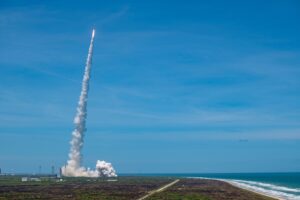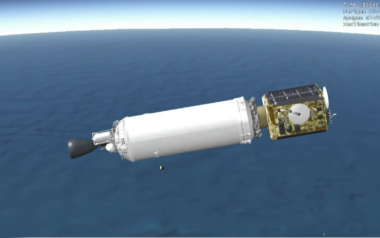ULA launches U.S. Space Force missile-warning satellite, two rideshare cubesats
By Sandra Erwin

WASHINGTON — A United Launch Alliance Atlas 5 rocket carrying a U.S. Space Force missile-warning satellite and two small payloads lifted off May 18 at 1:37 p.m. Eastern from Space Launch Complex-41 at Cape Canaveral Space Force Station, Florida.
The primary payload, SBIRS GEO-5, is the fifth of the Space Based Infrared System network of satellites and hosted payloads in geosynchronous Earth orbit and highly elliptical orbit. The satellites use scanning and staring infrared sensors to detect ballistic missile launches anywhere on the globe.
The launch had been scheduled for May 17 but was scrubbed during fueling preparations due to a malfunctioning temperature sensor.

About 16 minutes and 30 seconds after liftoff, two rideshare payloads were released from the rocket’s Centaur upper stage aft bulkhead into orbit. The 12U cubesats known as Technology Demonstration Orbiters TDO-3 and TDO-4 carried multiple U.S. government payloads for the U.S. Air Force Academy.
Nearly 43 minutes after liftoff, the SBIRS GEO-5 satellite separated from the upper stage and deployed to a geosynchronous transfer orbit.
SBIRS GEO satellites are made by Lockheed Martin. The $1 billion GEO-5 is the first built on the LM 2100 bus that was designed with enhanced security features. Lockheed Martin is now producing SBIRS GEO-6, the final satellite of the constellation projected to launch in 2022.
The Atlas 5 for this mission had a four-meter in diameter fairing, and two side-mounted solid rocket boosters. The Centaur upper stage was powered by a single Aerojet Rocketdyne RL10 C-1-1 engine.
Gary Wentz, ULA’s vice president of government and commercial programs, told reporters the RL10 C-1-1 is a higher performance engine than the RL10 C-1 flown in previous Atlas 5 missions. He said this was the first operational mission for the RL-10 C-1-1 that has a 3D-printed core main injector. The engine will power the upper stage of ULA’s next-generation rocket, the Vulcan Centaur.
This was the first launch of 2021 for the Atlas 5 and the 87th overall. Atlas 5 launched the first four SBIRS GEO satellites in 2011, 2013, 2017 and 2018. SBIRS GEO-6 also will launch on an Atlas 5 rocket.
Wentz said the company is building a larger aft bulkhead for Vulcan’s Centaur 5 upper stage so it’s able to carry more secondary payloads.
Vulcan is expected to fly its first mission later this year and begin launching National Security Space Launch missions in 2022. The Atlas 5 will continue to launch civil and commercial payloads, and still has six remaining NSSL missions under contract from the U.S. Space Force’s Space and Missile Systems Center.
Following the launch of SBIRS GEO-5, SMC Commander Lt. Gen. John Thompson said national security space launch is a “critical part of SMC’s holistic approach to deliver capability at the speed of relevance to secure the global commons.”
May 18, 2021 at 11:55PM
via SpaceNews read more...

Post a Comment